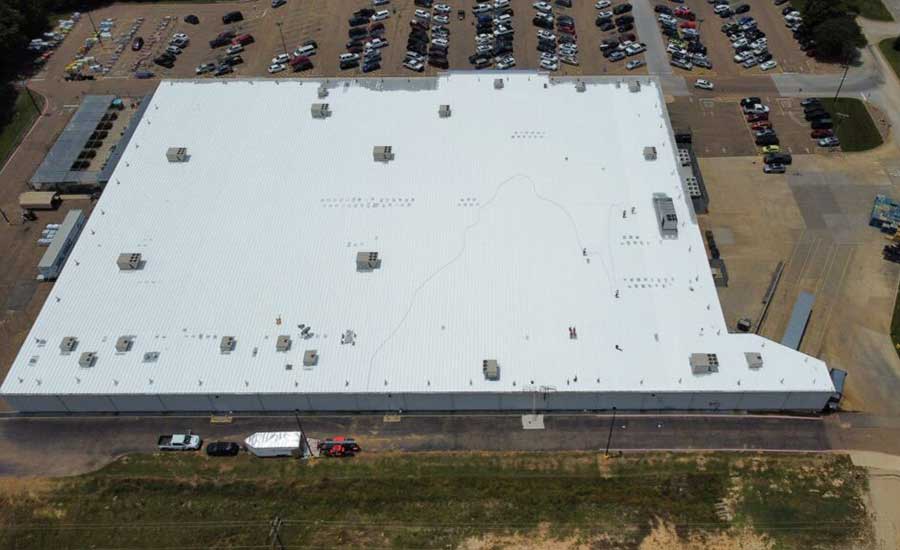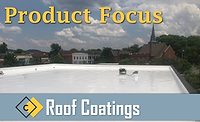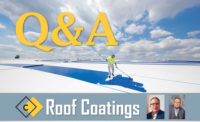Coatings Section
Big Box Store Chills Out with Cool Roof Coatings
Transforming Thermal Efficiency with Cool Roof Coating at a Fortune 500 Big Box Store

Photos courtesy of NanoTech.
According to the Department of Energy’s Commercial Buildings Energy Consumption Survey, there were 5.9 million commercial buildings in the United States in 2018, covering 97 billion square feet of floor space. That year, they consumed 6.8 quadrillion British thermal units of energy, translating to $141 billion spent on electricity and natural gas. With stringent energy-related regulations on the horizon, big corporations are seeking innovative and cost-effective solutions to reduce their carbon footprint.
One of the principal challenges for large facilities is maintaining optimal internal temperatures, especially when the building design and materials exacerbate heat retention. A Fortune 500 big box store recently chose NanoTech Materials, Inc., to apply its Cool Roof Coat to a 180,000-square-foot retail facility with a 30-foot ceiling and a trapezoidal metal roof to maximize energy efficiency. Here are the highlights of what they found.
The Challenge
The retail facility, a single-story building with expansive square footage, faced substantial thermal management issues. The building's trapezoidal metal roof, which had never been coated, contributed to high internal temperatures. During initial baseline scans, the surface temperature of the uncoated roof reached a scorching 149 degrees Fahrenheit, while the ceiling temperature underneath the batt insulation was recorded at 112.28 degrees Fahrenheit (44.6 degrees Celsius). These conditions were measured with an ambient outside temperature of 90 degrees Fahrenheit.
Such high internal temperatures meant that the store’s HVAC system was under constant strain, working tirelessly to bring the internal temperature down from 112 degrees Fahrenheit to a more comfortable 70 degrees Fahrenheit for ground-level customers and employees. Excessive heat increases energy consumption and operational costs and poses potential risks to product integrity and customer comfort.
In addition, the HVAC system was the single most significant contributor to the facility’s Scope 2 carbon footprint. The parent company had recently pledged an aggressive Net Zero strategy to shareholders and knew that a dramatic reduction in energy use across its owned buildings portfolio was the fastest way to achieve this. As such, regional facility managers were under intense pressure to reduce their locations’ overall energy use.
The Solution
In search of a solution to address thermal challenges and reduce the workload on the building’s HVAC, the company decided to implement a cool roof coat solution, a high-performance reflective roof coating designed to reduce heat absorption and improve energy efficiency. In searching for vendors that could be a good fit, the company was introduced to NanoTech Materials’ new advanced formulation, which promised significant reductions in surface temperatures. The goal was trifold: alleviate the burden on the HVAC system, significantly reduce the building’s Scope 2 CO2 footprint, and ultimately impact the company’s bottom line.

Cool roof solutions help clients meet energy regulations and enhance project value through energy savings and improved building performance.
The Technology
The NanoTech Materials Cool Roof Coat leverages the company’s proprietary technology, the Insulative Ceramic Particle (ICP), which is integrated into building materials and coatings for heat control. This innovation goes far beyond traditional reflective coatings by significantly reducing heat transfer through the thickness of the coating. Instead of simply reflecting heat away, the coating creates a physical barrier that stops the heat through low thermal conductivity. The technology is based on the energy band theory, a departure from low-mass technologies (aerogels) or reactive chemistry (intumescent).
The coating incorporates ICP, an acrylic coating that significantly reduces heat transfer by increasing the heat resistance of the materials it applies to. It reflects sunlight within the visible light spectrum, emits solar radiation from the UV and infrared spectrum, and increases the material's heat resistance, lowering indoor temperatures by 25-45 degrees Fahrenheit and significantly reducing the carbon emissions of the building. Conventional roofing materials often lack the necessary thermal insulation, resulting in higher energy usage for air conditioning, increased utility costs, and elevated greenhouse gas emissions. Reflective coatings designed to reduce heat absorption lose effectiveness over time due to dirt accumulation and environmental wear. The company projects the material can generate energy savings from 20% up to 50%, far surpassing the typical 15% savings of traditional reflective coatings.
Its ability to withstand harsh environments also ensures long-term performance and reliability. The coating is UV resistant, waterproof, and maintains no-crack flexibility. It also protects against hail up to 2 inches in diameter. The product can be easily applied using spray-on or roll-on methods and does not contain reportable volatile organic compounds.
Implementation
The application was meticulously planned and executed to ensure no disruption to store operations. The coating process involved several steps. The roof surface was thoroughly cleaned to remove debris, dust, and any existing contaminants. This step was crucial for ensuring proper adhesion of the coating. The coating was applied evenly across the entire 180,000-square-foot roof using advanced spray equipment. Two coating layers were applied to achieve the desired thickness and uniformity.
Quality control checks were conducted throughout the application process to ensure the coating was applied correctly and consistently. This included verifying the thickness of the coating and inspecting for any missed spots or inconsistencies.
The coating comes with a 20-year NDL warranty, is walkable in 90 minutes, and is rain-safe within eight hours. It can be applied in temperatures ranging from 41 to 200 degrees Fahrenheit and has a mechanical bond cure.
Results
The impact was immediately apparent. Post-application scans revealed a dramatic reduction in temperatures. The internal ceiling temperature dropped to a much more manageable 73 degrees Fahrenheit, starkly contrasting to the previous 112 degrees Fahrenheit. This significant decrease in internal temperature had several key benefits. The HVAC system no longer had to work as hard to maintain indoor temperatures, leading to a 49% reduction in the cooling component of HVAC use. This not only lowered energy consumption but also extended the lifespan of the HVAC equipment. Lowering the HVAC load decreased electricity bills, providing a quick return on investment for the coating application.
The store also minimized its carbon footprint by reducing energy consumption, contributing to its sustainability goals.
Industry Impact
In the evolving landscape of commercial building management, introducing this technology presents significant opportunities for roofing contractors. By incorporating advanced cool roof technologies, contractors can diversify their services, leading to higher-value projects and increased revenue potential. Expertise in these technologies provides a competitive edge, meeting commercial clients' growing energy efficiency and sustainability demands.
Contractors can foster long-term client relationships by addressing ongoing challenges like energy costs and carbon footprint reduction, resulting in repeat business and referrals. Cool roof solutions help clients meet stringent energy regulations and enhance project value through significant energy savings and improved building performance.
Integrating advanced roofing solutions into services positions contractors as trusted advisors opens up new avenues of revenue, and drives client satisfaction.
Conclusion
Applying NanoTech Materials Cool Roof Coat to the 180,000-square-foot retail facility demonstrates the transformative potential of advanced roofing solutions for improving thermal efficiency and reducing operational costs. This project highlights the significant benefits of proactive thermal management and innovative roofing technologies, providing a sustainable solution that aligns with the store's environmental objectives.
The success of this project underscores the importance of addressing thermal challenges from the top down, showcasing the value of energy-efficient roofing solutions. For roofing contractors, it illustrates the growing opportunities in the commercial sector for advanced, sustainable technologies, positioning them as essential partners in creating more cost-effective commercial buildings.
Looking for a reprint of this article?
From high-res PDFs to custom plaques, order your copy today!






